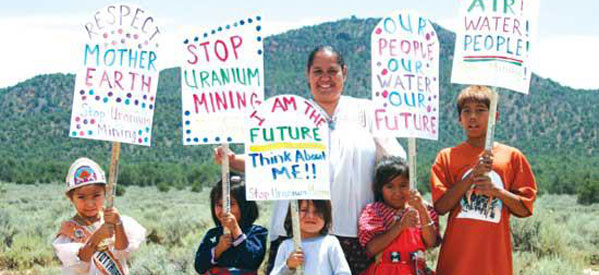In Edinburgh on the 17th and 18th of April at the annual meeting of Abolition 2000, a delegation from the Arizona based campaign group, Mama Bears Brigade, presented the plight of indigenous people around the Grand Canyon who are fighting against a mining company currently reopening shafts that were closed in the 1990s.
Besides the terrible effects caused by the dispersal of radioactive material on the local population, the mine basically sticks two fingers up at the locals who consider the whole area to be a place of great spiritual importance. In the words of one of the campaigners in Edinburgh, “It’s as if we would come to St Paul’s Cathedral or the Vatican and sink a mine shaft in it.”
A former tribal chairman said, “The site is the location of the abdomen of the Mother, a deity that gave birth to the Havasupais. Here our lives, and the Earth, are renewed each year… we believe the mine will destroy our Mother and bring death among us.”
The mining project, undertaken by a Canadian corporation, Energy Fuels Inc., based in Toronto, is being carried out 17 miles (27 km) south of the Grand Canyon National Park on land which is not only sacred to the Havasupai Indians who have been in the region for 800 years, but also upstream and upwind of their homes. The implication for the health of the local population is significant.
According to a factsheet by International Physicians for the Prevention of Nuclear War:
“Not only does natural uranium from the ore give off radioactivity, serious health risks are posed by the heaps, tailings*, and evaporation ponds. The left over rock itself is radioactive and the slurry and chemicals used to make ‘yellow cake’ are highly toxic. One of the dangers that the tailings pose is the contamination of ground water through the porous separating layer, erosion and seeping rainwater. Another danger is caused by insufficient covering of the tailings. Erosion through wind carries radioactive particles and radon many kilometres away from the heaps.”
[* materials left over after the process of separating the valuable fraction from the uneconomic fraction]
The area has been mined in the past and the local population have been constantly filing actions in court to prevent it, the latest in March 2013. After a ruling on the 20th of March, the area is now protected for a further 20 years from new mining projects, but old shafts can be reopened as they had received permits in the past. Scientists and campaigners argue that science wasn’t fully aware of the dangers of uranium mining to health when those permits were granted, especially how underground water is affected.
“Today’s ruling protects not only the Grand Canyon’s watershed, but millions of acres of other public land that have been withdrawn to protect natural values from destructive mining,” said Taylor McKinnon with the Center for Biological Diversity. “By upholding the federal withdrawal authority, today’s ruling is good news for public lands, water and wildlife.”
The danger from mining at the existing site is not only restricted to the local population though. According to the National Geographic website, every year, some 5 million people flock to the Grand Canyon, designated as one of the seven natural wonders of the world by CNN.
The Mama Bears came to Edinburgh to make their case to Abolition 2000 to adopt a declaration to ban uranium mining worldwide. Uranium mining frequently affects indigenous populations from US indigenous tribes, to the Tuareg people in Niger and Aboriginal Australians among others.
Abolition 2000 have been conscious of the effects throughout the entire nuclear chain, from uranium mining to nuclear test explosions, on indigenous populations ever since the network’s formation in 1995, and in 1997 a delegation visited Moorea in French Occupied Polynesia to see the impacts on human health for themselves, to show their solidarity and to raise awareness of the issue worldwide.
At the 2013 meeting in Edinburgh, those present unanimously adopted the following declaration:
Call for a Global Ban on Uranium Mining
Recalling the Moorea Declaration, adopted by the Abolition 2000 Conference held in Moorea, Te Ao Maohi, (French Occupied Polynesia) in 1997, which recognised that “colonised and indigenous peoples have, in the large part borne the brunt of nuclear devastation – from the mining of uranium and the testing of nuclear weapons on indigenous peoples’ land, to the dumping, storage and transport of plutonium and nuclear wastes, and the theft of land for nuclear infrastructure,” we call upon all governments, local and national, to permanently ban uranium mining within their territories and to ban both the import and export of uranium.
Without uranium, nuclear reactors cannot operate; without uranium, plutonium cannot be produced; without uranium or plutonium, nuclear weapons production is not possible. Cutting off the supply of uranium will reveal the contradictions inherent in the entire nuclear chain. It will eventually reduce the availability of fissile materials which can be fashioned into weapons of mass destruction. All existing stocks should be safely rendered unusable and securely stored.
All stages of the nuclear chain, from mining to power production to testing and storage of waste, expose surrounding populations to extremely long-lived mutagenic radionuclides that can lead to birth defects, cancers and other devastating diseases.
We reject the permanent contamination of our water, land and air so that a few multi-billion dollar corporations can make short-term, highly subsidised profits.
— Adopted by the participants of the Abolition 2000 Annual General Meeting held in Edinburgh, Scotland, April 17- 18, 2013










